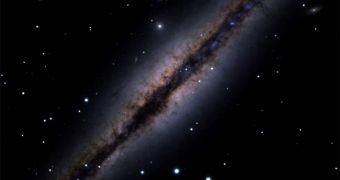Interstellar dust and gas permeates the whole interstellar and intergalactic space, blocking significant amounts of light along the way. But until now, it was unknown exactly how much light was shielded by dust and gas, mostly because most astronomers believe that the effect is irrelevant. New calculations reveal that dust may block as much as half the light emitted from stars and galaxies.
"I was shocked by the sheer scale of the effect. Most people just kind of said, 'We suspect dust is a minor problem.' I spent much of my career working on deep images from Hubble and I've always ignored dust almost entirely", says astronomer Simon Driver from the University of St. Andrews.
Prior to the calculations, astronomers approximated that dust might account for a drop of only 10 percent in the overall star and galaxy brightness. But if the new findings are confirmed, then this would mean that calculations regarding the intrinsic brightness of many celestial objects would need to be recalculated, and that the night sky is in reality twice as bright as we see it.
"This is a strong, clear-cut result. We've really got to take dust seriously and we've got to make large adjustments to our magnitude calculations", Driver said.
Interstellar dust is made up of carbon and silicate grains only a few thousandths of a millimeter across, and can be generally found inside galaxies. Most of the time, intergalactic space is clear of such dust clouds.
The calculations made by Driver are based on a collection of images of 10,000 galaxies, created by him and his team by using the Newton Telescope on La Palma. He then counted the number of galaxies directly facing us and those tilted at 90 degrees in relation to the position of our planet. If dust is taken out of the equation, then the number of galaxies should be roughly equal, but in reality it is far more likely that we find less galaxies edge-on to us, because in spiral galaxies interstellar dust lies in the galactic disc, not in the galactic nuclei. This in turn, would block the majority of optical emissions coming from the central nucleus, rendering them invisible.
According to the study, there are about 70 percent less edge-on observable galaxies than those facing us. The preliminary results of the study were then combined with a mode of dust distribution in galaxies created by Cristina Popescu from the University of Central Lancashire and Richard Tuffs from the Max Plank Institute for Nuclear Physics.
"It's been a revelation to many people in the community, but there are small groups that had a suspicion this was coming. I wouldn't be surprised if there's a refinement of the result, but I think the result is basically here to stay", Driver said.

 14 DAY TRIAL //
14 DAY TRIAL //